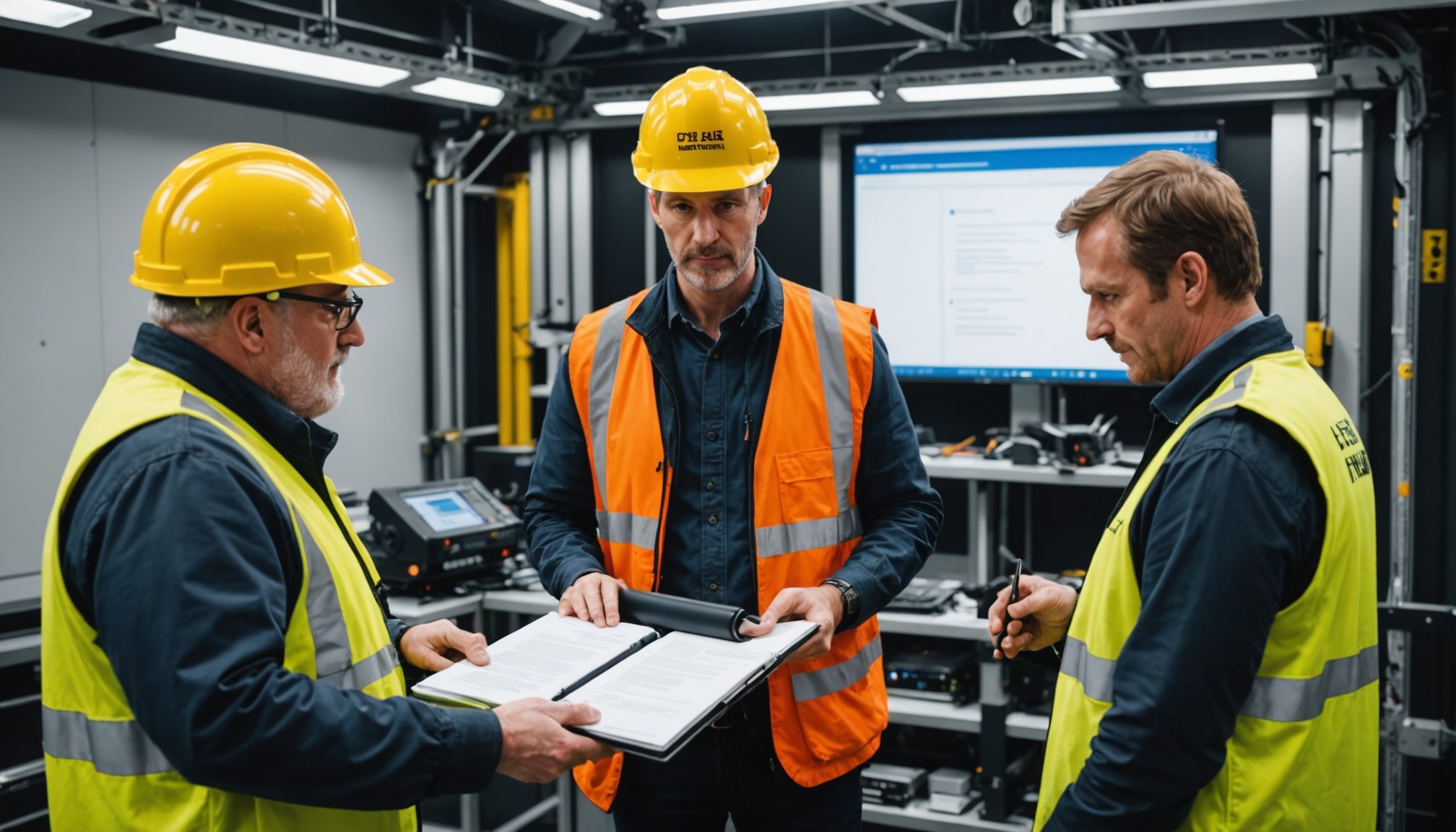Overview of Health and Safety Regulations in UK Film Production
Health and safety regulations in the UK film industry are essential for protecting everyone involved, from actors to crew. These regulations ensure that film production compliance is met and UK film safety standards are upheld. They not only protect individuals but also safeguard the industry against costly accidents or legal issues.
The legal framework governing film production safety in the UK is multifaceted. It integrates a range of laws and guidelines designed to address different aspects of health and safety. Central to this framework is adherence to the Health and Safety at Work Act 1974, which mandates that employers ensure the safety of their workers.
Have you seen this : Mastering ethical ai practices and data privacy: an essential resource for uk startups in the ai field
Key regulatory bodies like the Health and Safety Executive (HSE) play pivotal roles in monitoring and enforcing compliance. They provide guidelines, conduct inspections, and have the authority to enforce penalties for non-compliance. Their oversight is critical to maintaining high film production compliance standards.
Understanding and following these UK film safety standards helps film productions run smoothly and reduces the risk of incidents. Being informed about these regulations and the roles of involved bodies helps create safer working environments in UK film production.
Additional reading : Your essential guide to building a compliant uk online marketplace for educational resources: navigating intellectual property regulations
Essential Legal Requirements
Understanding the legal requirements for film production is crucial for ensuring safety and compliance. Central to these requirements are specific safety legislations that each film project must adhere to. These include the Health and Safety at Work Act 1974, Management of Health and Safety at Work Regulations 1999, and various industry codes of practice.
Producers and crew members shoulder specific responsibilities under these laws. Producers must ensure a safe working environment and conduct rigorous risk assessments to identify potential hazards. Crew members, on the other hand, are expected to follow safety protocols and report any unsafe conditions.
Non-compliance with these film industry regulations can result in severe penalties. Legal consequences may include fines, suspension of production, or even imprisonment in extreme cases. For example, a notable case involved a production crew being fined for neglecting to secure heavy equipment, which led to a serious accident on set.
Adhering to safety legislation not only prevents such incidents but also protects the production and its members from legal repercussions. Therefore, ensuring compliance is an integral part of the production process, safeguarding all involved and maintaining industry standards.
On-Set Safety Checklists
Maintaining safety standards on set necessitates comprehensive safety checklists, crucial for ensuring all potential risks in film production are addressed. These checklists function as practical guides throughout various phases of production, from pre-production to post-production, helping to catalogue and manage potential hazards effectively.
Pre-Production Phase: At this stage, the checklist should include securing permits, conducting initial site inspections, and ensuring emergency procedures and contacts are in place. Production Phase: By this point, daily equipment checks, ensuring clear communication channels, and implementing safe work practices become the focus. Post-Production Phase: Here, the emphasis shifts to ensuring that the site is cleared safely and any residual risks are documented for future reference.
Customizing safety checklists to fit the specific requirements of a film project is vital. This involves identifying unique production elements, such as special effects or stunts, assessing their risks, and incorporating additional safety measures. Keeping the checklists dynamic and adaptable ensures they remain effective tools in protecting all involved, fostering an environment where safety is seamlessly integrated into daily on-set practices. Not only do these checklists promote production safety, but they also contribute significantly to the risk assessment and management process.
Training and Certifications for Film Crew
Ensuring safety on set begins with comprehensive training requirements and acquiring appropriate safety certifications. Training programs are essential in equipping film crew members with the skills needed to identify and manage safety risks effectively. These programs range from general health and safety awareness to specialised courses focused on handling dangerous equipment or stunts.
Recommended Certifications: Several certifications stand out for their relevance. The First Aid at Work certification is fundamental, providing crew with the ability to respond to medical emergencies promptly. Additionally, obtaining the IOSH Managing Safely certificate helps crew members understand health and safety responsibilities pertinent to their roles.
Resources for Accredited Training: Finding credible training providers is vital. The British Safety Council and the National Examination Board in Occupational Safety and Health (NEBOSH) are renowned for offering quality courses tailored to the film industry. They serve as excellent resources for crew members to pursue safety education and certification tailored to the unique challenges of film production.
Incorporating regular safety training and encouraging certification among crew members not only boosts competence but also fosters a safer environment on set. By investing in education, film productions can significantly reduce the likelihood of accidents and enhance overall safety compliance.
Risk Assessment Procedures
Understanding risk assessment is crucial in managing film production safely. This process begins with hazard identification, which involves recognising potential dangers on set. To effectively conduct a risk assessment, follow these steps:
-
Identify Hazards: Look for anything that may cause harm, like faulty equipment or hazardous materials. For instance, electrical equipment could pose a risk of electrocution.
-
Assess Risks: Determine the likelihood and severity of each identified hazard. Evaluate who might be harmed and how. This involves understanding the impact of potential accidents on both crew and equipment.
-
Control Measures: Implement strategies to mitigate identified risks. Use protective gear, ensure regular safety checks, and enforce safety protocols. For example, secure loose cables and provide training for specific tasks.
-
Review and Update: Continue to assess and refine safety measures as the production progresses. Document any changes and ensure the crew is informed.
Common hazards in film production include slips and falls, pyrotechnics accidents, and set construction missteps. Effective safety management strategies are essential, incorporating regular safety meetings and involving all team members in the risk mitigation process, ensuring a proactive approach to on-set safety.
Creating a Culture of Safety on Set
Developing a robust safety culture on set is vital for ensuring the well-being of all film crew members and maintaining high safety standards. Encouraging a proactive safety mindset involves integrating safety into everyday on-set practices and fostering open communication and teamwork.
Best Practices: Establishing clear safety protocols and providing regular updates can significantly enhance crew communication. Encourage crew members to actively participate in safety meetings and to voice any concerns or suggestions regarding on-set safety.
Communication and Teamwork: Effective on-set practices rely heavily on strong communication. Utilizing tools like daily safety briefings and clear signage can keep everyone informed about potential hazards. Teamwork is enhanced through role-specific safety responsibilities, ensuring that every crew member understands their part in maintaining safety.
Case Studies: Examining successful safety cultures in productions can offer valuable insights. Some productions have implemented continuous safety training, resulting in reduced incidents and increased vigilance on set. For example, a renowned studio emphasized zero-tolerance for unsafe behaviour, leading to a safer working environment and fewer accidents.
Building a safety-conscious environment fosters trust and cooperation, ultimately making the film production process smoother and more secure for everyone involved.
Resources and Further Reading
Exploring film safety resources can enhance the understanding and application of safety practices in UK film production. Official regulatory documents such as the Health and Safety at Work Act 1974 provide detailed legal guidelines. It’s essential to familiarize with these documents to ensure full compliance.
For comprehensive safety guidelines, the Health and Safety Executive (HSE) offers valuable information and templates to aid productions. The HSE’s website is a primary online resource, providing access to a range of safety standards applicable to the film industry.
Various industry associations such as the Broadcasting, Entertainment, Cinematograph and Theatre Union (BECTU) also deliver guidance and support for adhering to safety regulations. These organizations can be instrumental for film crews seeking best practices and updates regarding safety protocols.
For further learning, several books and articles delve into the intricacies of health and safety in film production. Recommendations include guides on implementation of safety protocols and case studies highlighting successful safety practices on sets.
Training materials from reputable providers like the British Safety Council and NEBOSH are also beneficial, offering structured curriculums on safety management tailored to the film sector, helping crews stay informed and prepared.











